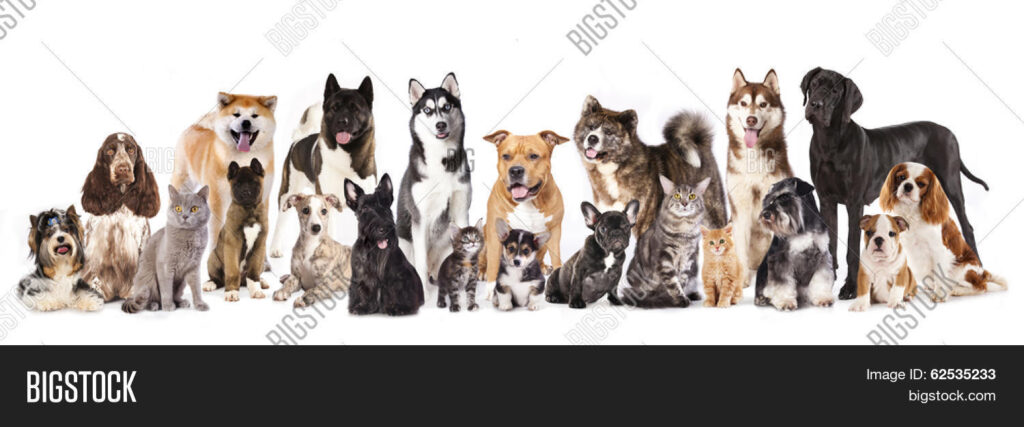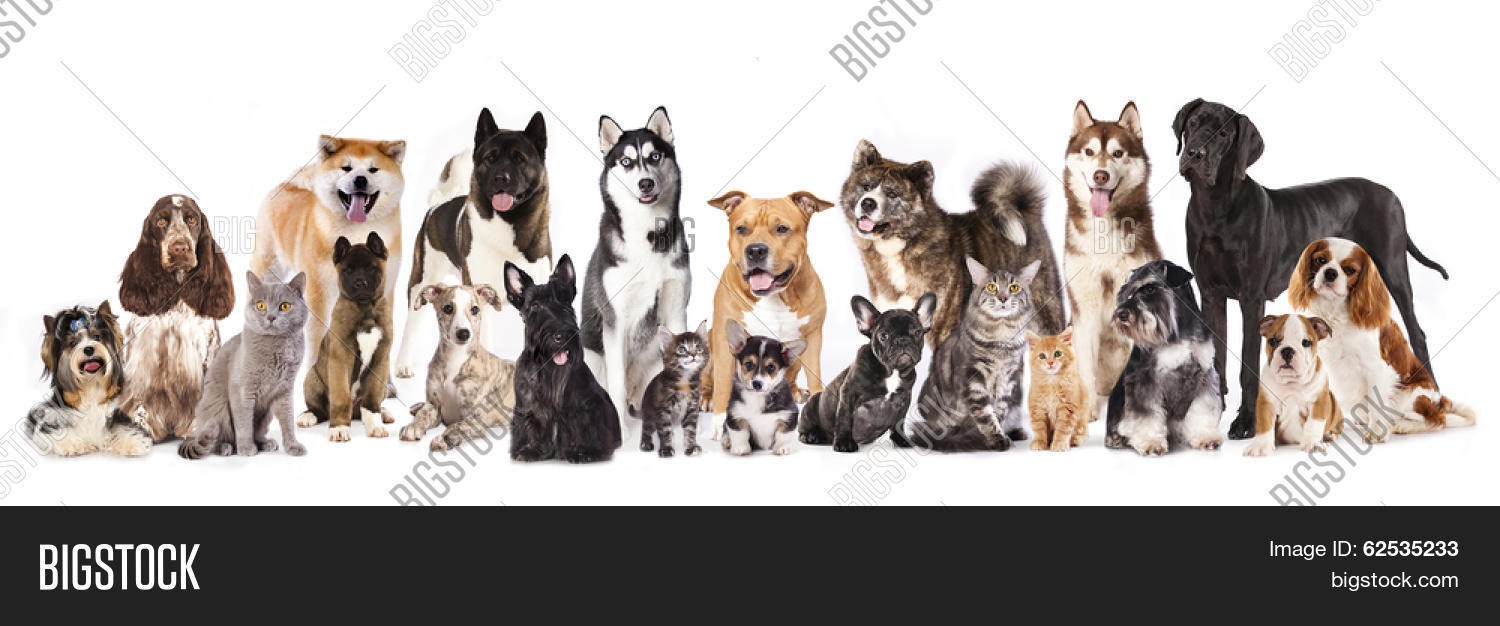
Navigating the Complexities of Coexistence: Understanding a Group of Dogs and Cats Living Together
The age-old adage of cats and dogs being natural enemies often overshadows the reality that these two species can, and often do, coexist peacefully. Understanding the dynamics within a group of dogs and cats sharing a household requires careful consideration of their individual personalities, breeds, and the environment they inhabit. This article delves into the nuances of fostering a harmonious relationship between a group of dogs and cats, exploring strategies for successful introductions, managing potential conflicts, and creating a safe and enriching environment for all.
Understanding the Potential Challenges
Before attempting to integrate a group of dogs and cats, it’s crucial to acknowledge the potential challenges. These challenges stem from inherent differences in communication styles, play behaviors, and predatory instincts. Dogs, often more social and boisterous, may misinterpret a cat’s aloofness as a challenge, leading to unwanted chasing or harassment. Cats, on the other hand, can be easily intimidated by a dog’s high energy and may resort to defensive behaviors like hissing, swatting, or hiding.
- Predatory Instincts: While domesticated, dogs retain some predatory instincts that can be triggered by a cat’s movements. Certain breeds, particularly those bred for hunting or herding, may be more prone to chasing.
- Communication Misunderstandings: Dogs and cats communicate differently. A dog’s wagging tail, often a sign of friendliness, can be interpreted by a cat as aggression. Similarly, a cat’s slow blink, a sign of contentment, may go unnoticed by a dog.
- Resource Guarding: Competition for resources like food, water, toys, and resting spaces can lead to conflict within a group of dogs and cats.
Successful Introductions: A Step-by-Step Guide
The introduction process is paramount to establishing a positive dynamic between a group of dogs and cats. A gradual and controlled introduction minimizes stress and allows animals to adjust to each other’s presence at their own pace.
Scent Swapping
Begin by allowing the animals to acclimate to each other’s scent without direct interaction. Swap bedding, toys, or towels between the dog and cat. This allows them to become familiar with each other’s smell in a non-threatening environment.
Controlled Visual Introductions
Once the animals seem comfortable with each other’s scent, introduce them visually through a barrier like a baby gate or a closed door with a crack. Keep the dog on a leash and reward calm behavior with treats. Limit these visual introductions to short periods and gradually increase the duration as they become more comfortable. Ensure the cat has an easy escape route if feeling threatened.
Supervised Interactions
After several successful visual introductions, allow supervised interactions in a controlled environment. Keep the dog on a leash and monitor their behavior closely. Redirect any chasing or aggressive behavior immediately. Reward calm interactions with praise and treats. Keep initial interactions brief and gradually increase the duration as they become more comfortable. The goal is to create positive associations with each other’s presence. Never leave a group of dogs and cats unsupervised until you are completely confident in their ability to coexist peacefully. [See also: Introducing a New Cat to Your Dog]
Creating a Harmonious Environment
A well-managed environment can significantly reduce the likelihood of conflict and promote a harmonious relationship within a group of dogs and cats. This involves providing ample resources, creating safe spaces, and managing their interactions effectively.
Adequate Resources
Ensure each animal has its own food and water bowls, beds, and toys. Place these resources in separate locations to minimize competition. Cats should have access to elevated resting spots, such as cat trees or shelves, where they can feel safe and secure. Providing multiple litter boxes, ideally one more than the number of cats, is also essential.
Safe Spaces
Cats need safe spaces where they can retreat to when feeling overwhelmed or threatened. These spaces should be easily accessible to the cat but inaccessible to the dog. Consider creating vertical territory with cat trees or shelves, allowing cats to observe their surroundings from a safe vantage point. Ensure the cat has an escape route in every room.
Managing Interactions
Supervise interactions between a group of dogs and cats, especially during mealtimes and playtime. If you notice any signs of tension or aggression, separate the animals immediately. Positive reinforcement training can be used to teach the dog to ignore the cat or to perform alternative behaviors, such as sitting or staying, when the cat is present. Never punish the dog for chasing or showing interest in the cat, as this can create negative associations and exacerbate the problem.
Addressing Behavioral Issues
If conflicts persist despite your best efforts, it’s important to address any underlying behavioral issues. This may involve consulting with a veterinarian or a certified animal behaviorist. They can help identify any medical or behavioral problems that may be contributing to the conflict and recommend appropriate treatment strategies. Common behavioral issues that can affect the dynamics within a group of dogs and cats include anxiety, aggression, and resource guarding.
Anxiety
Anxious dogs or cats may be more prone to aggressive or defensive behaviors. Identifying and addressing the source of the anxiety is crucial. This may involve providing a more predictable routine, reducing environmental stressors, or using calming aids like pheromone diffusers or calming supplements.
Aggression
Aggression between a group of dogs and cats can be a serious problem that requires professional intervention. It’s important to determine the cause of the aggression, whether it’s fear-based, territorial, or resource-related. A behaviorist can help you develop a behavior modification plan to address the underlying cause and reduce the likelihood of future conflicts.
Resource Guarding
Resource guarding occurs when an animal becomes possessive of food, toys, or other resources and displays aggressive behavior to protect them. This can be managed by providing separate feeding areas, removing toys when the animals are together, and teaching the dog to trade resources for treats. [See also: Dealing with Resource Guarding in Dogs]
The Benefits of a Multi-Pet Household
Despite the challenges, successfully integrating a group of dogs and cats can bring immense joy and companionship to a household. The animals can provide each other with social interaction, mental stimulation, and emotional support. Watching them play together, groom each other, and cuddle up for naps can be incredibly rewarding. Moreover, a multi-pet household can create a more vibrant and engaging environment for everyone.
Conclusion
Creating a harmonious environment for a group of dogs and cats requires patience, understanding, and a willingness to adapt to their individual needs. By following the guidelines outlined in this article, you can increase the likelihood of a successful integration and enjoy the many benefits of a multi-pet household. Remember that every animal is an individual, and what works for one group of dogs and cats may not work for another. Be prepared to adjust your approach as needed and seek professional help if you encounter any challenges. The key is to prioritize the safety and well-being of all the animals involved and to create an environment where they can thrive together. The successful integration of a group of dogs and cats showcases that the old adage of them being enemies can be overcome with patience and understanding. The joy and companionship they bring to a household is well worth the effort. Remember, creating a safe and enriching environment for a group of dogs and cats is an ongoing process, requiring constant observation and adaptation. By investing the time and effort, you can foster a harmonious relationship that enriches the lives of all your furry companions, creating a happy and loving home for everyone, even when dealing with a group of dogs and cats. The reward of seeing a group of dogs and cats coexisting peacefully is a testament to the power of understanding and patience. Ultimately, fostering a positive relationship within a group of dogs and cats is a rewarding experience that enriches the lives of both the animals and their human companions.

